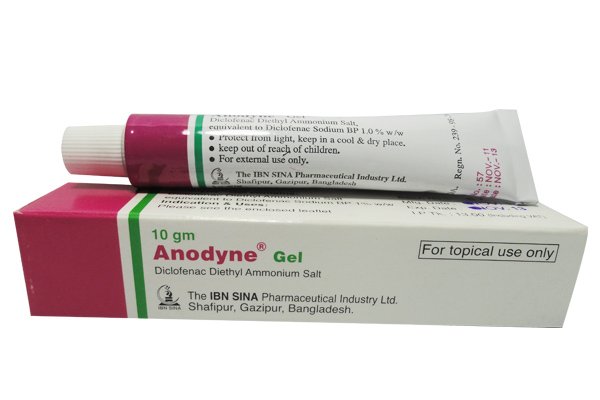
ANODYNE GEL
DICLOFENAC SODIUM BP
| NAME | STRENGTH | PACK SIZE | DOSAGE FORM |
|---|---|---|---|
| ANODYNE GEL 20 GM | 20 GM | 20 GM | GEL |
Anodyne gel: Each 100 gm gel contains 1.16 gm Diclofenac Diethyl Ammonium salt equivalent to 1 gm Diclofenac Sodium BP.
Anodyne gel is an anti- Inflammatory, analgesic preparation designed for external use. The non-greasy gel preparation can easily be rubbed into the skin, which exerts soothing and cooling effects. When applied locally, the active substance penetrates the skin, accumulates the underlying tissue and controls both acute and chronic inflammatory reactions. In presence of traumatic or rheumatic inflammation, Anodyne gel reduces inflammatory swelling and also provides effective relief from tenderness and pain on movement.
Anodyne gel is indicated for local treatment of traumatic inflammation of tendons, ligaments, muscles and joints due to sprains, strains and bruises and in localized forms of soft tissue rheumatism, e.g. tenosynovitis and bursitis. Also indicated in localized rheumatic disease e.g. osteoarthrosis of peripheral joints and of the vertebral column periarthropathy.
Depending on the size of the area to be treated, 2-4 gm of Anodyne gel should be applied to the skin 3-4 times daily to the affected area gently. Anodyne gel may also be given in addition to treatment with other dosage forms of Diclofenac.
Diclofenac gel should not be given to the patient hypersensitive to Diclofenac, Aspirin or other NSAIDs. In view of insufficient clinical data Diclofenac gel is not recommended during pregnancy.
Anodyne gel should be applied only to the intact skin surface and not to skin wounds or open injury. It shouldn't come in contact with eyes or mucous membrane. After application the hand should be washed well. It shouldn't be taken by mouth.
Diclofenac gel is well tolerated. Reddening of the skin and skin rash may occasionally occur. Photosensitivity reactions have been observed in isolated cases, when applied to relatively large area of skin over prolonged period.
Diclofenac should not be prescribed during pregnancy,
unless there are compelling reasons for doing so. The lowest effective
dosage should be used. This type of drugs are not recommended during the
last trimester of pregnancy. Very small quantities of diclofenac may be
detected in breast milk, but no undesirable effects on the infant are to be
expected.
Since no experience has been acquired with diclofenac in pregnancy or
lactation, it is not recommended for use in these circumstances.
No drug interaction during treatment with diclofenac
have been reported.
Symptoms following acute NSAID overdoses are usually limited to lethargy, drowsiness, nausea, vomiting, and epigastric pain, which are generally reversible with supportive care. Gastrointestinal bleeding can occur. Hypertension, acute renal failure, respiratory depression and coma may occur, but are rare. Anaphylactoid reactions have been reported with therapeutic ingestion of NSAIDs, and may occur following an overdose. Patients should be managed by symptomatic and supportive care following a NSAID overdose. There are no specific antidotes. Emesis and/or activated charcoal (60 to 100 g in adults, 1 to 2 g/kg in children) and/or osmotic cathartic may be indicated in patients seen within 4 hours of ingestion with symptoms or following a large overdose (5 to 10 times the usual dose). Forced diuresis, alkalinization of urine, hemodialysis, or hemoperfusion may not be useful due to high protein binding.
Store in a cool (below 30°C) and dry place protected from light and moisture. Keep out of the reach of children.
Each lamitube contains 20 gm gel.
